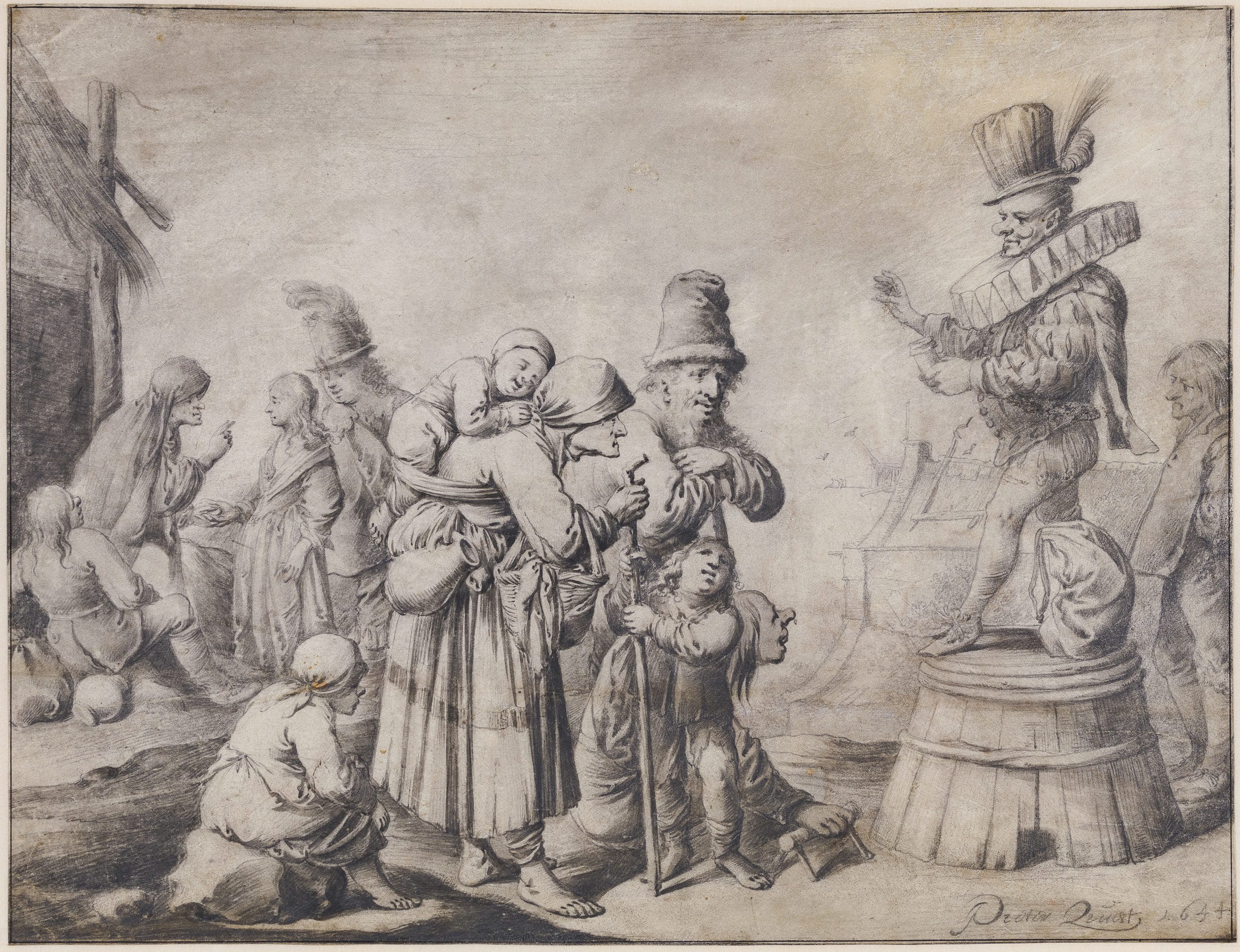PIETER QUAST (Amsterdam 1605/06 – 1647 Amsterdam)
Pieter Quast (Amsterdam 1605/06 – 1647 Amsterdam)
Village Kermesse with a Quack Doctor and a Fortune Teller
Black chalk and grey wash on vellum, black ink framing lines, 285 x 374 mm (11.2 x 14.7 inch)
Signed and dated ‘Pieter Quàst 1644’ (lower right)
***
Pieter Jansz Quast give his age as twenty-six when his marriage banns were published on June 29, 1632, the year in which the present drawing was executed.1 At the time, he lived in the Molensteeg in Amsterdam, where he was most likely born. Nothing is known of his parents or his life before his marriage, which took place on 19 December 1632 in Sloten, near Amsterdam. His bride was Annetje Splinter, who at least in the 1640s was active as a flower painter. Annetje was from The Hague, and the couple settled there before Quast joined the painters’ guild in 1634.
Quast failed to flourish in The Hague, which was an expensive place to live. His debts to a shopkeeper in 1640, to an innkeeper in 1641 ,and to a carpenter in 1642 were the subjects of court cases. Quast fared no better in Amsterdam, where he and his family were living in the Kalverstraat by 1st June 1643. On that date, Annetje was entertaining a clergyman from Utrecht. The subject turned to prostitutes, many of whom, according to the hostess, the visitor had patronized. The offended guest slashed her fase with a glass roemer – at which point her husband rushed in and held the pastor at knifepoint. During another episode in February 1644, two men entered the house and damaged a portrait, smeared it with paint and scratched it with knives. Financial problems continued, with rent not being paid by the Quasts in 1644. Pieter Quast was buried in the Nieuwe Kerk in 1647; his widow re-married the painter Jacob van Spreeuwen from Leiden.
Quast is best known as a painter of genre scenes and ‘merry companies’, but also painted portraits, religious and historical pictures. In The Hague he was influenced by Adriaen van de Venne (1589–1673). Quast’s work also shows an awareness of his contemporary Adriaen Brouwer (1605–1638), who studied in Haarlem with Frans Hals and lived in Amsterdam until 1631, when he returned to Antwerp. Quast offered a humorous, caricatural view of contemporary Dutch life. His works are populated with stock figures such as beggars, drinkers, quack doctors, dwarves, and the like, all readily recognisable to Quast’s audience.
Quast was a prolific draughtsman and made many sheets as finished works of art for early collectors. They were sometimes kept in albums, but also framed and displayed, as was for instance done by Joseph Coijmans and Jacoba Trip in Haarlem – their inventory of 1678 lists four ‘teyckeningen’ (drawings) by Quast in the ‘achterkamer’.2
This drawing is a particularly large and impressive work by the artist, with more figures than usual. It can be compared to Quast’s drawing Mocking of the Spaniard in the Morgan Library, New York (fig.).3 The clothing of the quack doctor standing on an upturned half barrel in our drawing is similar to that of the Spaniard in the Morgan sheet – the exuberant ruff collar, tall plumed hat and rest of the attire would presumably have been interpreted as Spanish by contemporary viewers, possibly worn by the quack to exude a feeling of exoticness and fake learning. At tle left, a fortune teller examines the hand of a lady, to the amusement of a bystander.
1. The best biography of quast is by B.A. Stanton-Hirst, ‘Pieter Quast and the Theatre’, Oud Holland 96 (1982), p. 213-37; see also Walter A. Liedtke, Dutch Paintings in the Metropolitan Museum of Art, New York/New Haven/London 2007, vol. I, pp. 539-40.
2. Inventory of 19 August 1678, no. 33 ‘2 teyckeningen van Pieter Quast’ (valued at 4 guilders) and another ‘2 teyckeningen van Pieter Quast’ (valued at 1 guilder and 10 stuivers); Pieter Biesboer, Collections of Paintings in Haarlem, 1572 – 1745, Los Angeles 2001, p. 249.
3. Black chalk and grey wash on vellum, 224 x 301 mm, inv. no. 2015.120; B.A. Stanton-Hirst, op. cit., p. 232, note 27.





